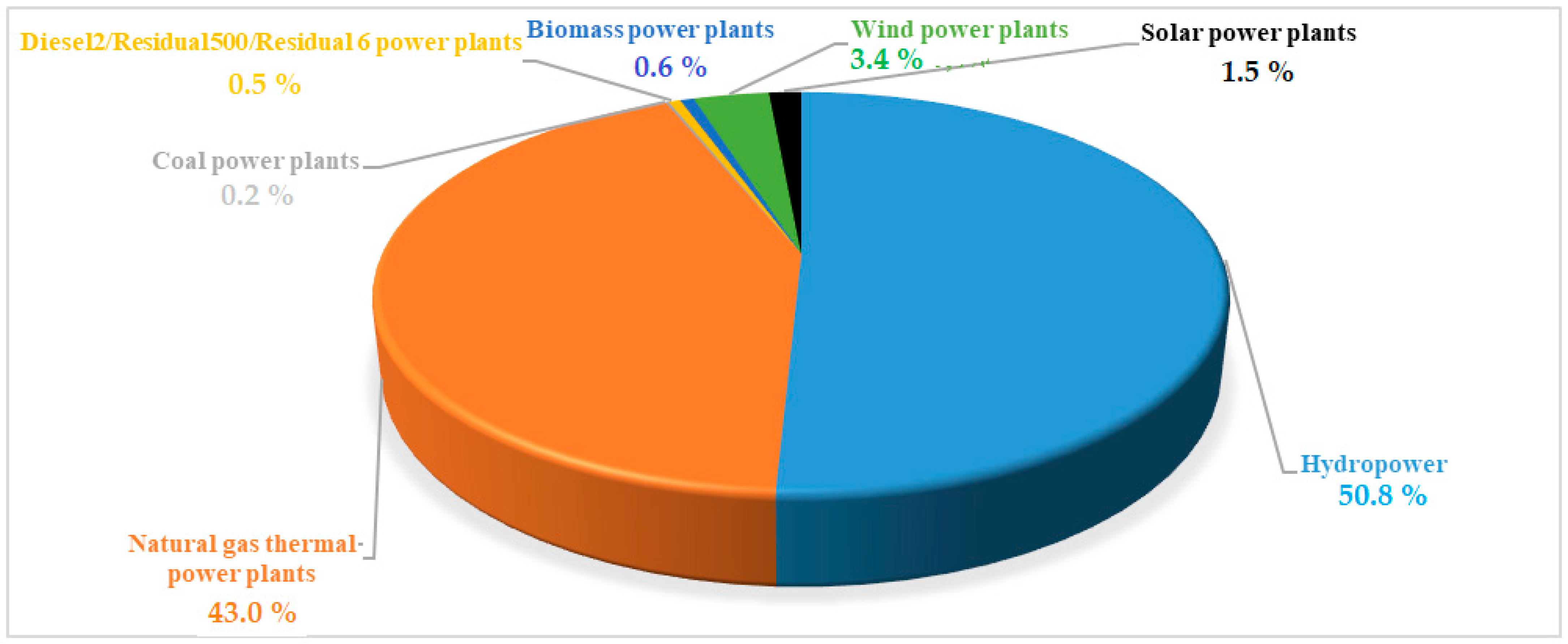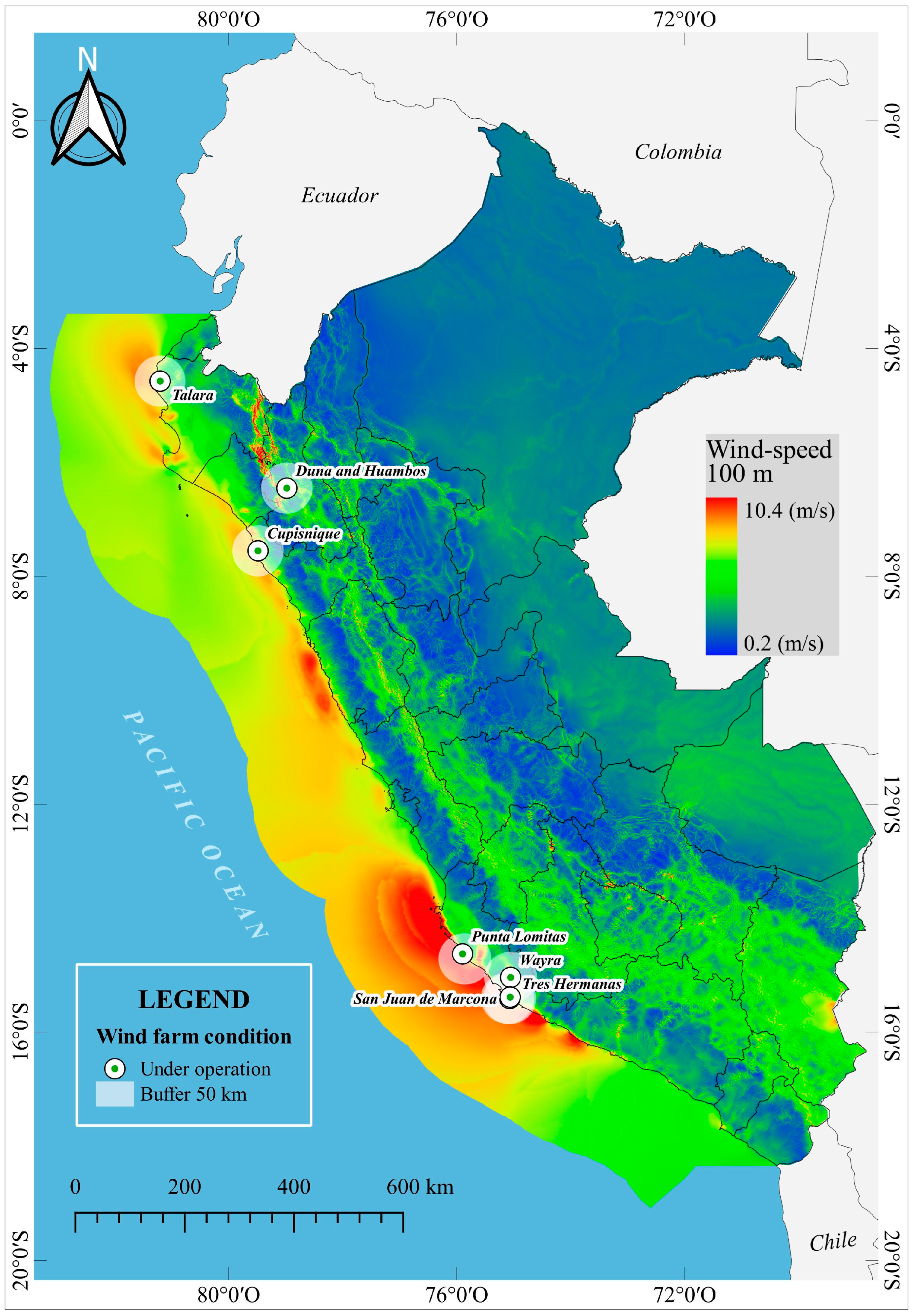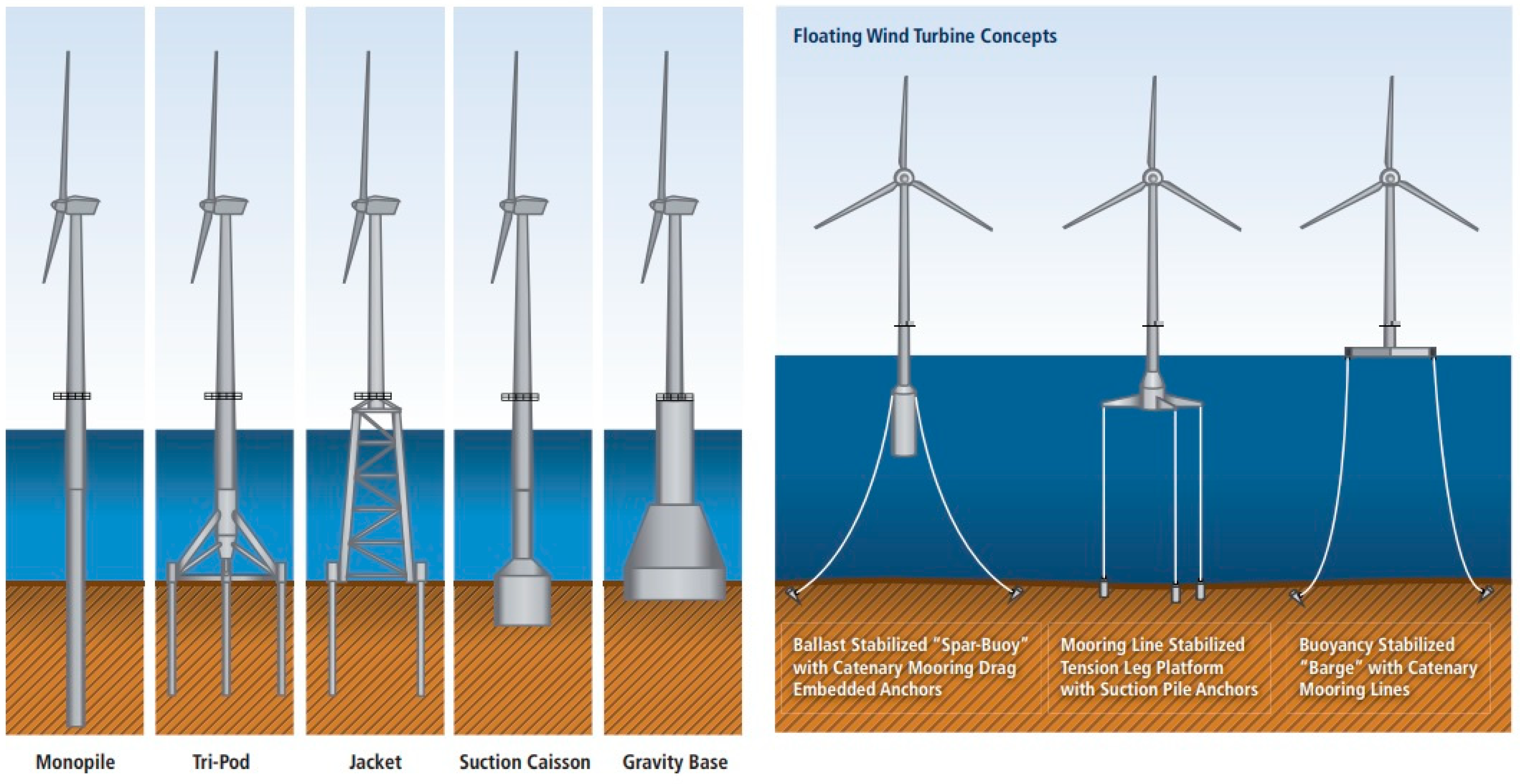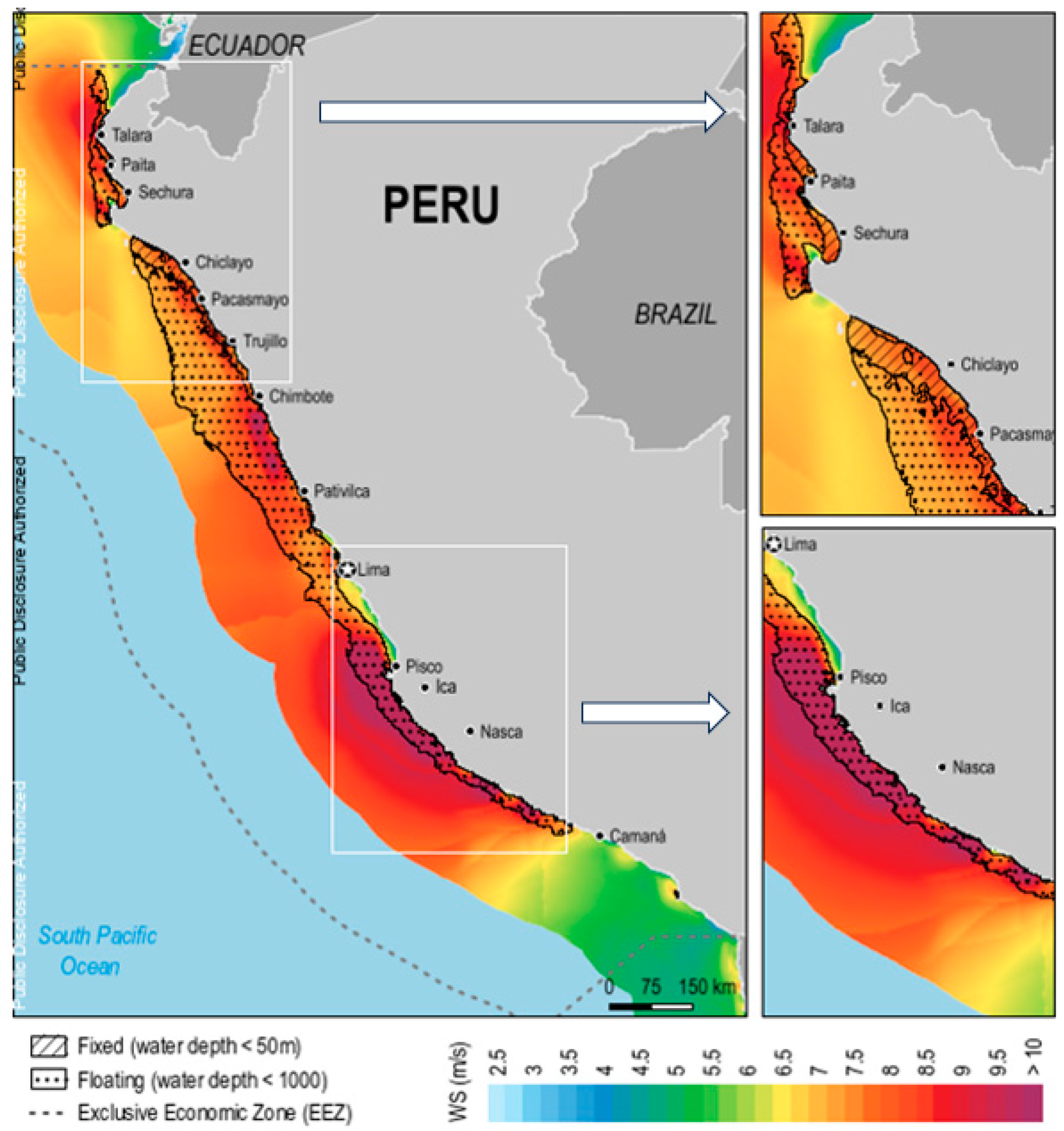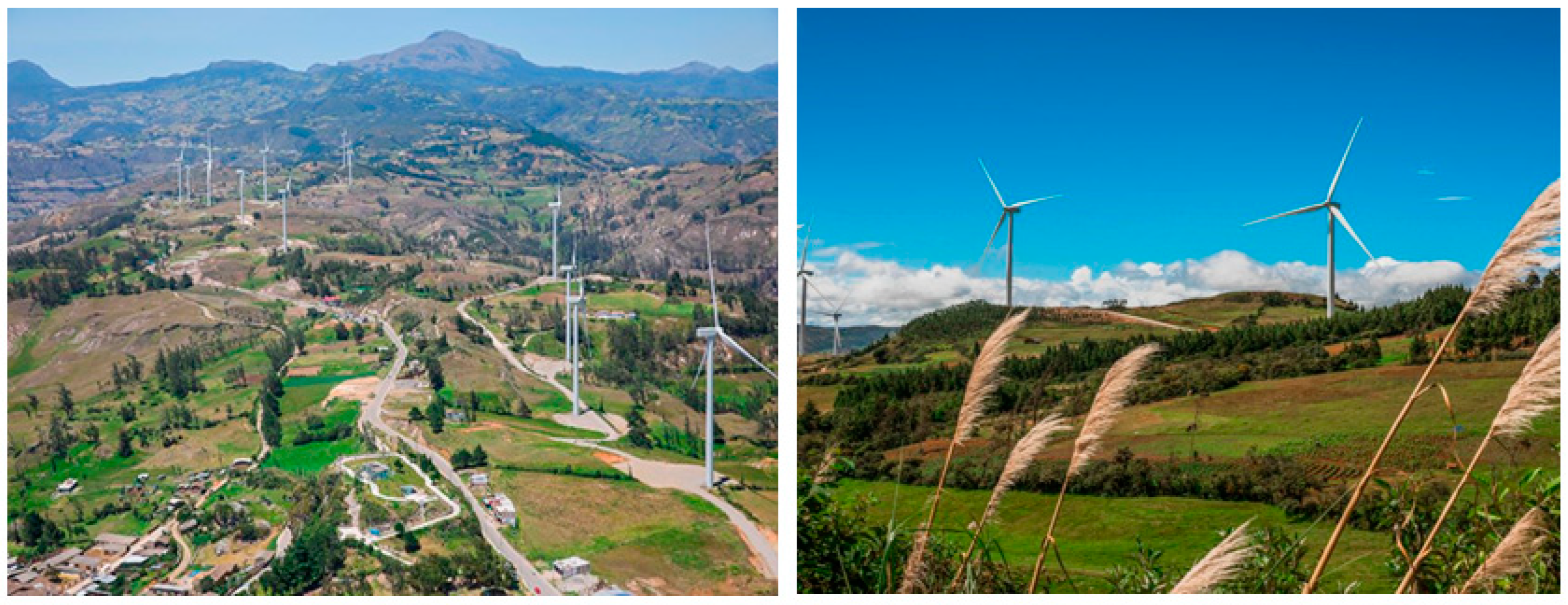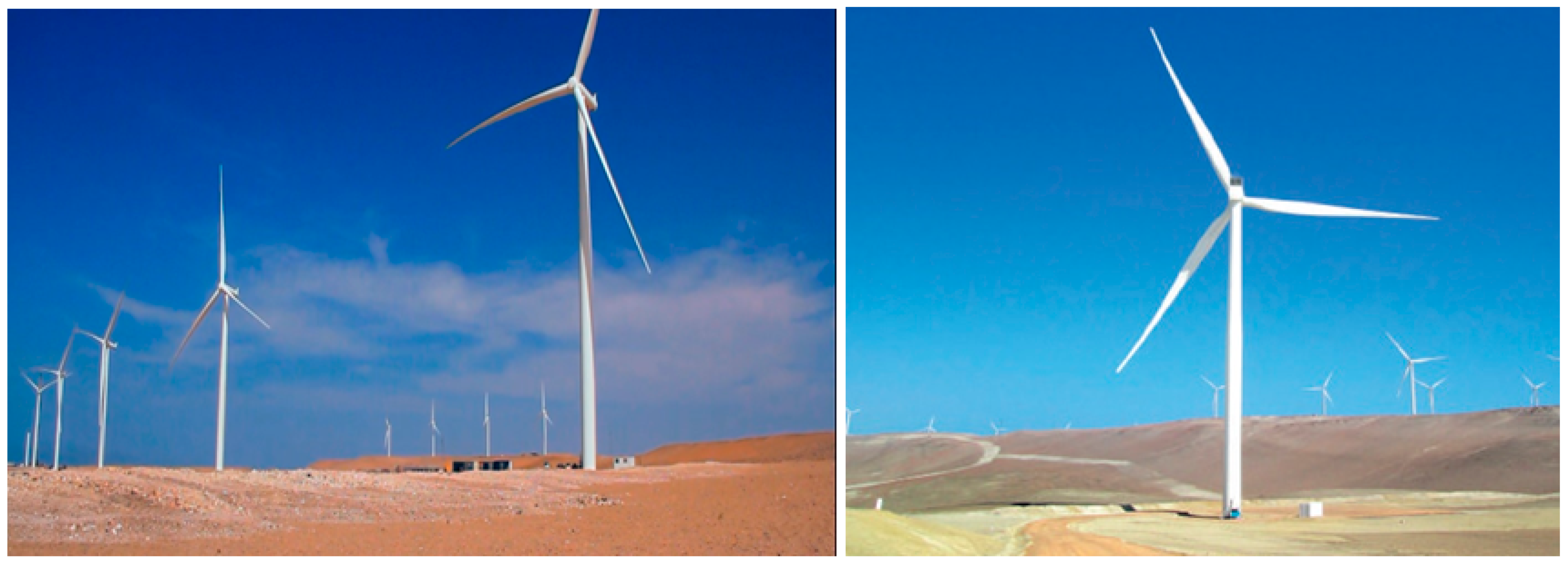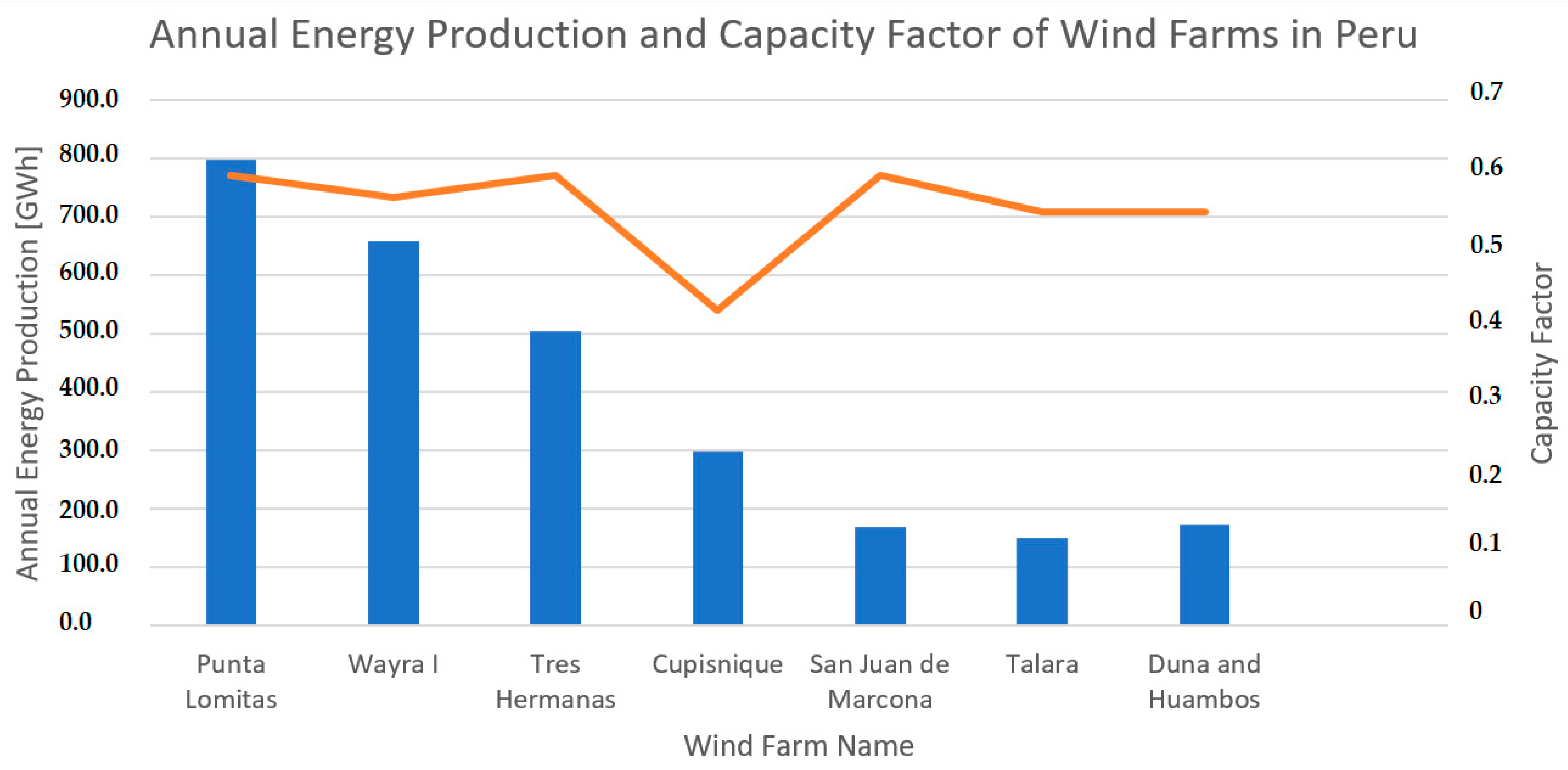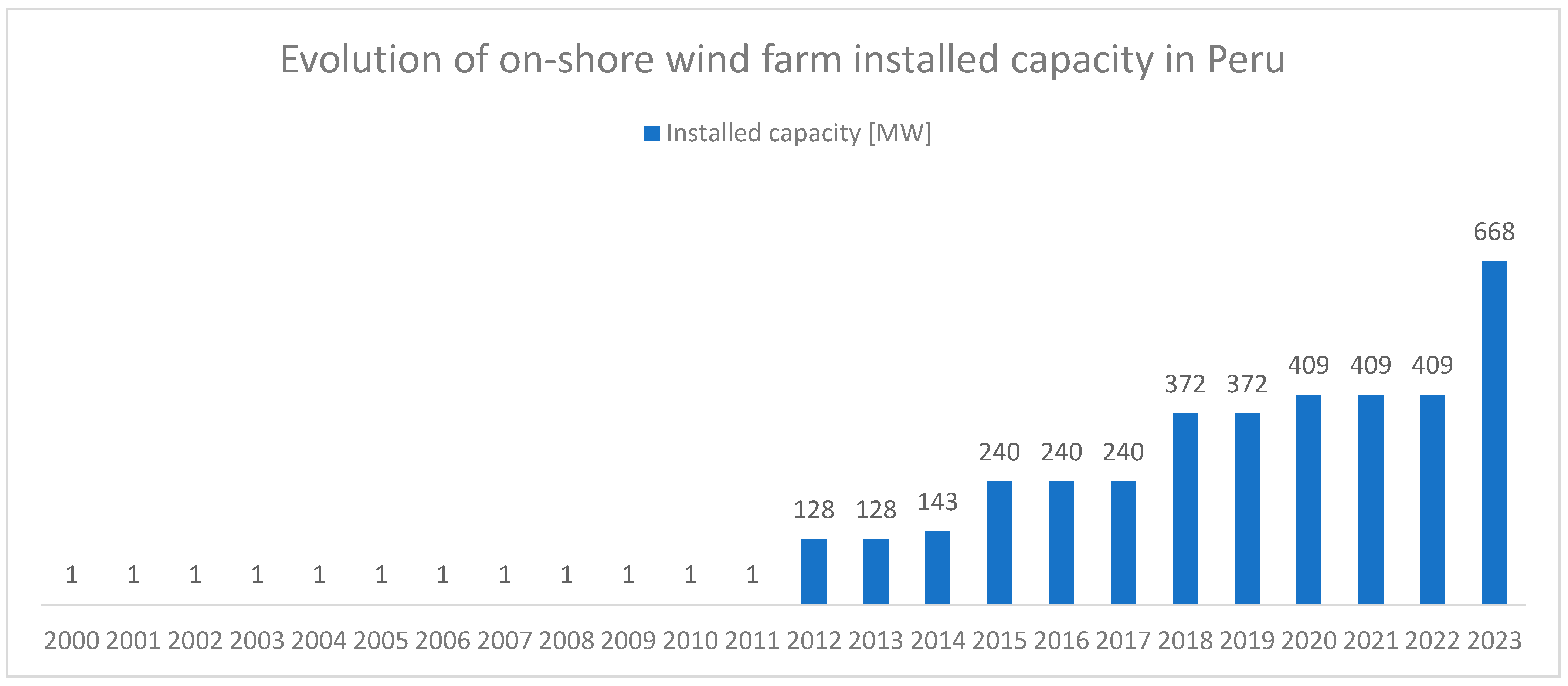4. Discussion
4.1. Recent Advances
Wind energy technology on an industrial scale has already been successfully implemented in Peru, being increasingly popular and a feasible alternative to apply in different places in the territory with wind resource potential. Considering the experience of on-shore wind farms in Peru since 2012, the main advantages and disadvantages are presented in
Table 15.
The main advantages highlighted in
Table 15 are that the environmental impacts in the territory with this renewable energy technology are low, and it is also highlighted that its operation and maintenance are easy to execute, while it also generates important employment opportunities mainly during its construction stage [
38,
39]. On the other hand, some of the disadvantages observed are as follows: it is a discontinuous energy source; it is conditioned to the intensity and direction of winds which can change suddenly; and it is not compatible with being implemented in territories of protected natural areas and/or archaeological/cultural heritage [
40,
41].
The implementation of the current seven wind farms has served as a precedent and constitutes the basis of the portfolio of future wind farm projects to be built in the north, center, and south of Peru. The experience acquired to date has allowed contractor companies to learn for the construction and assembly of wind farms. In addition, the training of specialized personnel in the operation of wind farms has been carried out, as well as experience has been acquired in the processes of processing environmental licenses for operating such plants and building trust relations with neighboring communities [
42].
The insertion of wind energy is contributing to the diversification of Peru’s energy matrix, allowing the use of a renewable source; however, its participation is still in its initial stage, despite the vast potential available.
The success stories of the projects in operation have allowed communities to be educated, making known a viable and feasible alternative which can coexist in a territory with the livelihoods of its inhabitants.
For this reason, studies are becoming increasingly necessary to locate wind farm infrastructure where the compromise between the use of wind potential and the minimization of the impacts on the environment is maximized, resulting in the better operation and sustainability of this renewable and alternative energy source [
43,
44].
Finally, it is important to highlight the contribution of wind energy to other industries, especially the mining sector. For example, the production of electrical energy from the Punta Lomitas wind power plant will allow for the electrical demand of the Quellaveco mine, a world-class copper mining project, to be supported with renewable energy sources, making it the first major mining site in Peru to use 100% green energy for its mine operations.
4.2. Challenges for the Implementation in the Territory
The wind resource of Peru presents characteristics of stability, both in its speed and predominant direction. This is due to the trade winds that come from the south and that, when they impact the terrestrial area, promote constant local winds, such as the Paracas and the Ica. However, despite this, Peru presents climatic phenomena known as El Niño and La Niña (ENSO), which modify the average wind speed in the years during which they occur. [
26]. Determining its seasonality is extremely important for wind analysis studies influencing energy production [
45].
The standard called IEC 61400-1 Wind Turbine Generator Systems [
33] identifies four classes of turbines for different wind conditions: Class I, whose average annual speeds are 10 m/s; Class II, with speeds of 8.5 m/s; Class III, with speeds of 7.5 m/s; and Class IV, with 6 m/s. In this sense, the best wind conditions are for Class I and Class II, as long as the probability of this kind of wind occurring is above 2000 hour per year.
According to the measurements of the SENAMHI meteorological stations distributed in the Peruvian territory, an interesting potential has been estimated in different points of the Peruvian coast and mountain range [
45] where the wind resource, measured at a height of 10 m, registers values for Class I and Class II, particularly in the areas of Ica, Piura, Lambayeque, La Libertad, Cajamarca, and Ancash.
Table 16 shows some points in these areas with great potential.
As can be seen in
Table 16, coastal areas, at low altitudes, present adequate conditions for using the wind resource. Taking as reference the 3 MW Enercon E-82 E3 wind turbine and considering a hub height of 100 m, the capacity factors that would be obtained in these locations are significant, which are indicated in
Table 17.
According
Table 17 in the regions of Ica and Cajamarca, extraordinary capacity factors are obtained. In the case of the Ica region, the main wind energy projects take place in this area. In the case of the Cajamarca region, where the capacity factor is 95%, infrastructure conditions do not allow for the installation of any equipment located at more than 5000 masl.
Concerning technological development, the Peruvian industry is adapting to the needs of the energy sector, which is why the training of human talent who can meet the challenges implicated in energy diversification.
The leap that has been made in using instruments for measurement, collection, and simulation is a task that energy-generating companies and research centers are carrying out; this sum of efforts with the government will allow the creation of digital tools for the quantification and characterization of wind resources.
The implementation of 5 MW wind turbines represents an important milestone for Peruvian engineering that guarantees the stability of the wind farm infrastructure in the country and reduces the risk of failure.
4.3. Futures Perspectives
Although an important and promising industrial development in renewable energy has been achieved in Peru through the on-shore wind farms in operation, the development and promotion of the implementation of renewable wind energy on a smaller scale still needs to be implemented, especially in rural areas, where it could generating energy supply for remote communities. This would benefit many communities that still do not have electricity, promoting rural electrification and access to energy by all citizens in a renewable, equitable, and non-polluting manner [
25,
26,
28].
The link between mining companies and energy companies that generate electricity from renewable energy sources will be a trend in the future, in which the search to achieve low-carbon economies will encourage these alliances. This also improves the reputation of mining activities, which translates into concrete actions of socio-environmental responsibility and giving back to the planet with cleaner and more sustainable extractive activities.
There are high expectations that the government of Peru will promote public policies that seek the implementation of wind farms in different places in the territory, which will allow the generation of renewable energy and provide access to clean energy to more inhabitants and productive activities. This can also be aligned to policies for the implementation of green hydrogen in the country.
It is necessary for Peru to consider as a reference the successful models of wind energy development implemented in neighboring Latin American countries, with the cases of Mexico, Brazil, Uruguay, Argentina, and Chile being references in this matter, countries in which there are an important number of wind farms in operation [
46,
47,
48,
49,
50].
In Peru, there is an interesting off-shore wind potential that has not yet been exploited. Although the off-shore potential is promising, there are some barriers, such as the bathymetric characteristics of the seabed off the coast of Peru and the associated costs [
51]. With respect to the conditions of the seabed, the complexity and depth of the Chile–Peru sea trench make the foundations of wind turbines at sea a challenge for engineering, testing the designs and construction processes for their implementation. Furthermore, tsunami events that occur every 100 years are a threat to off-shore wind farm facilities, where structural measures must be implemented to increase the resilience of these renewable energy systems. In general terms, it is possible to mention that off-shore wind technology is going from being a luxury version of renewable energies to a profitable and attractive option in some countries where the energy prices have not managed to decrease even due to the use of traditional renewable energy (wind, solar, hydraulic, geothermal, biomass, tidal, etc.) [
52]. In particular, for Peru, the prices of off-shore wind energy shown are above the current energy costs, so, surely, its appearance in these latitudes of the southern hemisphere will have to wait some more time.
The wind power plants in Peru corresponding to on-shore wind turbines are in sites that, until now, have presented adequate wind potential; however, given the complex site-specific conditions of Peru, considering the diverse characteristics of the topography, geography, and climate in the Andes region, the construction of these power plants demands high capital costs for developing electrical transmission networks and access to roads and bridges. For these reasons, the wind farm power plants currently in use are located mainly along the coast, where the Duna and Huambos wind farm is located at the highest altitude, with 2276 masl, but its annual energy production (per capita) does not exceed that of the wind farms found along the coast. Considering these issues, both the central zone and the northern zone of Peru are those that represent the greatest potential for a wind energy boom; hence, the growth scenarios in the coming years will be concentrated in these regions.
The current development of wind energy in Peru is in its initial stage. The analysis of the wind farms that are currently in operation has been presented in this article: their improvement has been the increase in the power of the wind turbines utilized, since it has gone from 2 MW 3 MW and 5 MW installed capacity.
Finally, it is possible to mention that the future of the generation of electrical energy from wind sources, considering the portfolio of investment projects in Peru, is promising, where an on-shore installed capacity of more than 7429 MW has been projected to be implemented in the next decades and, thus, meet the committed carbon neutrality goals by 2050.
5. Conclusions
Although greenhouse gas (GHG) emissions due to energy generation are not high in Peru, wind energy is presented as one of the alternatives with the greatest projection for decarbonization. Its technological maturity and the reduction in CAPEX and OPEX position it as the most attractive. Likewise, the hourly variability of wind resources means that production is mostly more noticeable during peak hours, which, in economic terms, allows for the recognition of firm power, making this type of project achieve a profitability in the order of 7%. The availability of resources on the Peruvian coast and mountain range is highly adequate; however, the restrictions on the accessibility to mountainous areas force the development of this technology to be on-shore, linked to coastal areas, which is why six of the seven wind power plants currently in operation are located in these types of areas. A different case occurs with the Duna and Huambos power plant of 36 MW, a wind farm plant located in the Andes, whose per capita production does not reach values similar to the rest of the wind farm plants.
In the Peruvian case, the greatest potential for wind energy according to the information from the 2016 Wind Atlas of Peru is in the coastal area, especially in the regions of Piura, Lambayeque, La Libertad, Ancash, Cajamarca, Ica, and Arequipa, with average wind speeds of 6 and 12 m/s (at an average wind turbine height of 100 m) for the development of both terrestrial and marine wind energy. In the Andes mountain range area, the wind speed is between 6 and 9 m/s, with Cajamarca being the most notable wind power region because it has a similar potential to the coastal regions. The Amazon area has less potential compared to the two regions mentioned above. Considering the wind farms currently in operation in Peru, there is a total installed capacity of 668 MW, which is equivalent to 3% of the usable on-shore wind energy potential of 20.5 GW.
The development of digital tools such as the implementation of artificial intelligence (AI) and the implementation of georeferenced systems is a need that must be addressed in the short term: the platforms available for accessing information are not unified, and the existing ones require a greater computing capacity and constant updates. Free-access climate data lack robustness and historical records, so the purchase of bankable data must be considered for pre-feasibility projects to reduce design uncertainties due to the lack of historical records of meteorological information.
In the case of Peru, the effects on the wind considering the El Niño and La Niña climatic phenomena (ENSO) and the effects of global climate change must be studied in more detail. Indeed, the periodicity of these plays a fundamental role in the design and sizing of wind power plants since the generation of electrical energy is seriously affected by them, which implies, at the national level, an increase in the marginal costs of generating electrical energy.
Therefore, the incorporation of wind power plants into the National Interconnected Electricity System (SEIN) has allowed a slow but sustained technological development, which has motivated the training of human talent, the generation of jobs, and the arrival of private investment.
On-shore wind energy will continue to grow gradually, mainly in the north and center of the country, which is why it is estimated that 7.4 GW of installed capacity will be incorporated in the coming years. Off-shore wind energy will require more in-depth studies to guarantee its implementation on the Peruvian coast, which has a complex bathymetry.
At the environmental level, environmental impact assessment (EIA) studies guarantee the installation of wind farm power plants in sites that meet the appropriate conditions, but it is essential to have information and protocols that guarantee the permanent protection of environmentally protected areas, the right to use soil, and care in the face of social conflicts.
With respect to economic terms, the government of Peru should avoid subsidizing on-shore wind energy, since it has demonstrated improvements in its efficiency and a reduction in its costs, in such a way as to allow for the realization of a route for off-shore wind energy that will require the creation of financing mechanisms.
Finally, Peru is a country in the process of growth and development, which will translate in the coming decades into the modernization of its electricity generation matrix with a solid base of renewable energy sources, with wind energy being a fundamental pillar in delivering their contribution to the mitigation of global climate change.

